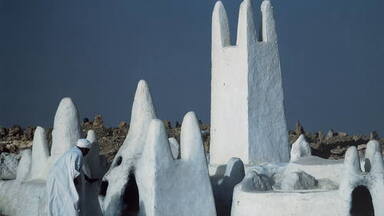Promoting traditional environmental knowledge in the M’Zab Valley (Algeria)
The traditional settlements of the M’Zab valley were adapted to their environment and climate. Floodable areas were occupied only by temporary structures and not by dwellings. Water infrastructure was a core community concern, and a community organisation managed the shared water infrastructure. The abandonment of these traditional practice has led to increased vulnerability to flooding.
To safeguard these values and improve environmental sustainability, the management authority has developed educational materials and workshops on traditional water management systems and wells,traditional construction techniques and the traditional construction management system.
About the M’Zab Valley
Located 600 km south of Algiers, in the heart of the Sahara Desert, the five ksour (fortified villages) of the M'Zab Valley form an extraordinarily homogenous ensemble constituting, in the desert, the mark of a sedentary and urban civilisation possessing an original culture that has preserved its cohesion throughout the centuries. Comprised of ksour and palm groves of El-Atteuf, Bounoura, Melika, Ghardaïa and Beni-Isguen (founded between 1012 and 1350), the M'Zab Valley has conserved practically the same way of life and the same building techniques since the 11th century, ordered as much by a specific social and cultural context, as by the need for adaptation to a hostile environment, the choice of which responded to a historic need for withdrawal and a defensive imperative. Each of these miniature citadels, surrounded by walls, is dominated by a mosque, the minaret of which functions as a watchtower. At the beginning of the first millennium, the Ibadis created in the M'Zab, with local materials, a vernacular architecture which, with its perfect adaptation to the environment and the simplicity of its forms, is an example and an influence for contemporary architecture and town-planning (Statement of Outstanding Universal Value).
Climate change-related impacts
The M’zab Valley is vulnerable to climate change, with periodic overflows becoming increasingly frequent (Djellouli Tabet and Sioussiou, 2009). In the face of climate change, there is a significant need to enhance the risk preparedness of the water distribution system. During the catastrophic floods of 2008, the damages were worsened by improper constructions and a lack of maintenance of water management infrastructure.
Traditional knowledge and practices / Indigenous knowledge
In the M’Zab Valley, traditional water management systems include both tangible and intangible components: a community organisation manages the channels and infrastructure that control water flow. Given the periodic overflow of the river, approximately every 25 years, traditional settlements were designed to prevent damage by flooding: floodable areas near the river were occupied only by temporary structures and not by dwellings. The abandonment of this planning practice has led to increased vulnerability to flooding.
Climate action solutions and strategies
Founded in 1970 as the “Atelier des etudes et de restauration de la Vallee du M’Zab”, the Office for the Protection and Promotion of the M’Zab Valley is a local management institution that, under the supervision of the Ministry of Culture, aims to promote heritage conservation, develop awareness-raising and education programmes, and promote local communities’ involvement in its preservation and management.
In line with this vision, the Office has created a number of technical guides and educational materials, which are available online, free of charge, in French and Arabic. The technical guides include clear explanations about construction principles, materials and techniques, in an accessible format and language and with large illustrations. The publications aim to raise awareness about cultural heritage values and guide residents in the maintenance and restoration of their buildings.
The educational materials produced include:
- Guides to façade maintenance and restoration for traditional buildings;
- Information material about heritage protection laws;
- Learning materials for traditional construction techniques such as stone paving and lime plastering;
- Guide to El-Orf, the traditional construction management system in the towns and palm groves in the M’Zab Valley; which contributes to climate knowledge;
- Brochures on traditional water management systems and wells;
- Guides for stone and earthen construction and limewashing;
- Inventories of historic sites and monuments, tangible and intangible heritage
The publications were accompanied by capacity-building workshops on traditional building techniques and materials. The workshops were directed towards technical offices, developers, technical services (urban planning, construction, housing, environment and public works), artisans, and more. The last of these workshops was organised in April 2020 in collaboration with the Algerian Centre for Earthen Cultural Heritage.
Several practical on-site workshops were organised in collaboration with cultural associations in order to train young local artisans in the maintenance of historic buildings and local construction materials. The programme was realised in close collaboration with the professional training programmes, so that the workshops can be recognised with a diploma. Managers have participated in specialised training programmes on the physical and chemical characteristics of local materials and their promotion, by involving university experts.
Furthermore, the Office has realised itinerant exhibitions on the different local construction materials, and several documentary films, including a film on limewashing. Recent planning initiatives incorporated modern and traditional know-how in water management to respond to water storage, distribution and evacuation needs.
Concerning the future, there is a significant need to enhance the risk preparedness of the water distribution system and choose more adapted facilities in this hyper-arid zone, as strategy for climate change adaptation. To reduce disaster risks, the M’zab valley watershed should be integrated in the management of settlements and palm groves (Djellouli Tabet and Sioussiou, 2009).
Source: Office for the Protection and Promotion of the M'Zab Valley, 2022; presentation by Mr Abdelouahb Zekagh during the World Heritage City Dialogues, 2021; Le bassin versant du M’zab, région méditerran diterranéenne hyperaride : ressources en eau, risques et gestion, Yamna Djellouli Taber, Rostom Sioussiou, 2009.
Contribution towards global goals
How does this case study contribute to the global commitments of sustainable development, climate change action and heritage conservation?
Sustainable development
The initiative aims to contribute towards sustainable development by addressing the following Sustainable Development Goals:

Target 6.b: by studying and promoting traditional water systems, owned and managed by the local communities, the initiative could contribute to strengthen the participation of local communities in water management.

Target 11.4: by studying, disseminating and preserving the historic building practices of the M'Zab Valley, the initiative aims to strengthen efforts to protect and safeguard the world’s cultural and natural heritage.
Target 11.b: by raising awareness about the connections between heritage, water and the city, the initiative could contribute towards the development of integrated policies towards inclusion, resource efficiency, mitigation and adaptation to climate change, resilience to disasters.

Target 13.1: the initiative aims to strengthen resilience and adaptive capacity to climate-related hazards and natural disasters, by learning from historic water and landscape management practices.
Climate change
The M’zab Valley is vulnerable to climate change, with periodic overflows becoming increasingly frequent (Djellouli Tabet and Sioussiou, 2009). In the face of climate change, there is a need to enhance the risk preparedness of the water distribution system. The vulnerability of the system was highlighted by the devastating 2008 floods.
Risk management, settlement planning, water management, traditional building techniques.
Preserving historical practices that contribute to resilience and disaster risk reduction, and incorporating them into resilience strategies with modern technical knowledge can be a strategy for climate change adaptation.
Historic Urban Landscape
The project aims to contribute to the implementation of the approach of the 2011 Recommendation on the Historic Urban Landscape by:
- Protecting and promoting the use of traditional construction techniques
- Promoting the engagement of local communities in heritage preservation and maintenance
Learn more
Discover more about the details of the case study and the stakeholders involved.
To learn more
- Visit the website of the Office for the Protection and Promotion of the M'Zab Valley
- Read Le bassin versant du M’zab, région méditerranne hyperaride : ressources en eau, risques et gestion, Yamna Djellouli Taber, Rostom Sioussiou, 2009, Séminaire International sur la gestion des bassins et la coopération dans la région Euro - Méditérranéenne.
Contact
Office for the Protection and Promotion of the M'Zab Valley
- Website: opvm.dz
- Address : Quartier KHETTALA Haut, 15 Villas, BP N° 446 CDD Ghardaïa, 47801
- Tel : +213 29 88 44 54
- E-mail : opvm@m-culture.gov.dz
Credits
© UNESCO, 2022. Project team: Jyoti Hosagrahar, Alba Zamarbide, Carlota Marijuán Rodríguez, Altynay Dyussekova, Mirna Ashraf Ali.
Cover image © UNESCO
Note: The cases shared in this platform address heritage protection practices in World Heritage sites and beyond. Items being showcased in this website do not entail any type of recognition or inclusion in the World Heritage list or any of its thematic programmes. The practices shared are not assessed in any way by the World Heritage Centre or presented here as model practices nor do they represent complete solutions to heritage management problems. The views expressed by experts and site managers are their own and do not necessarily reflect the views of the World Heritage Centre. The practices and views shared here are included as a way to provide insights and expand the dialogue on heritage conservation with a view to further urban heritage management practice in general.


